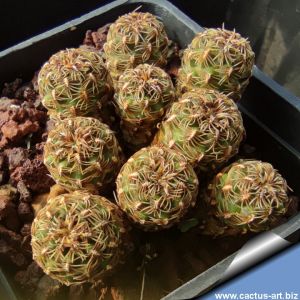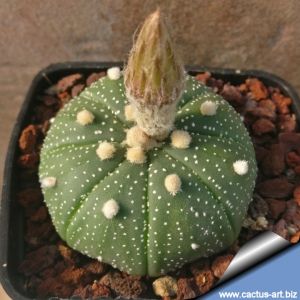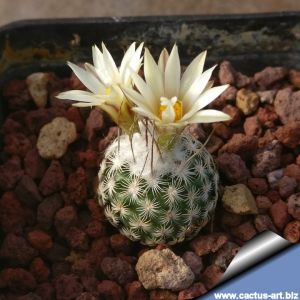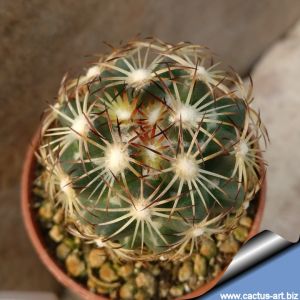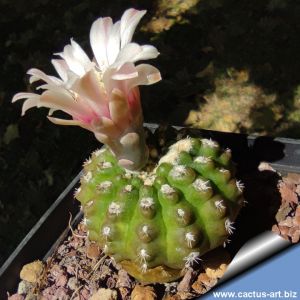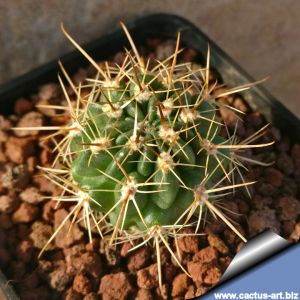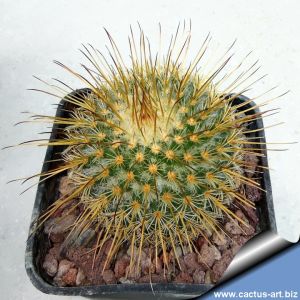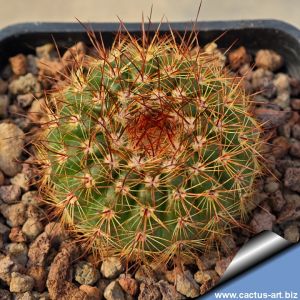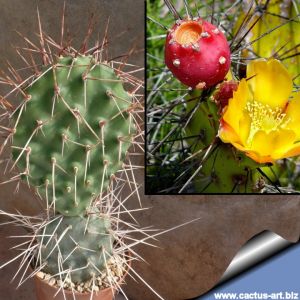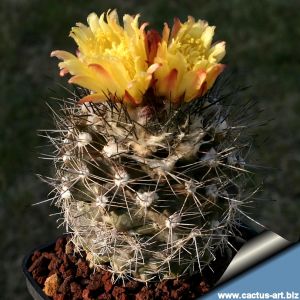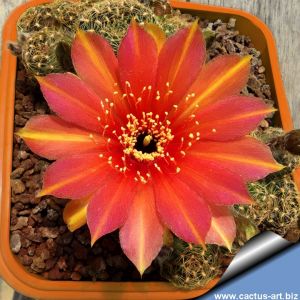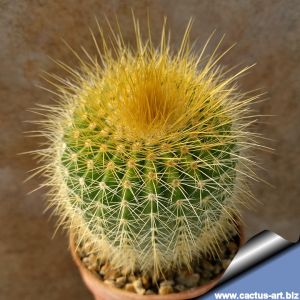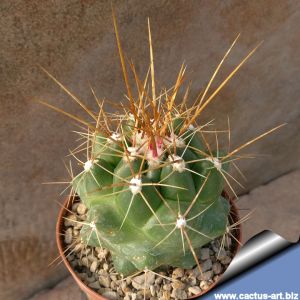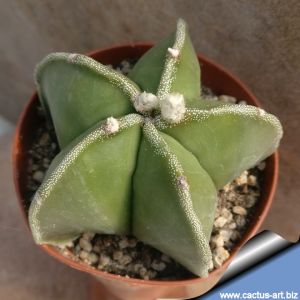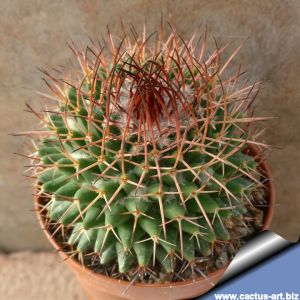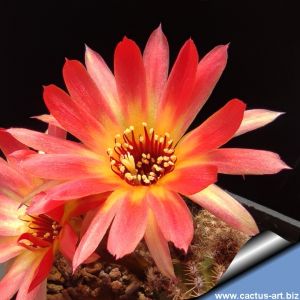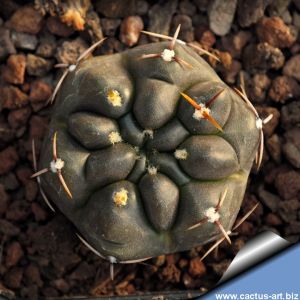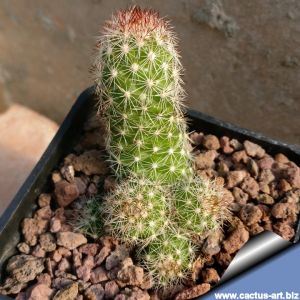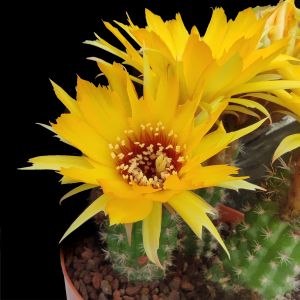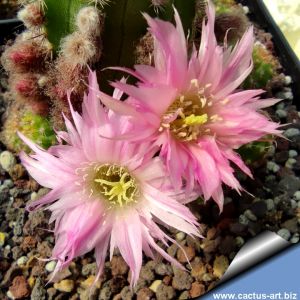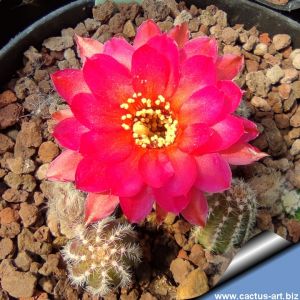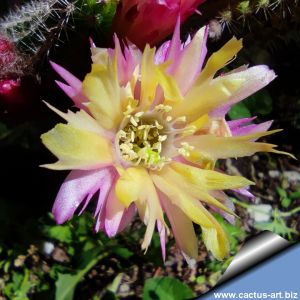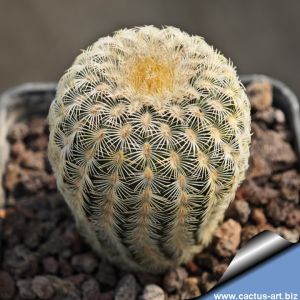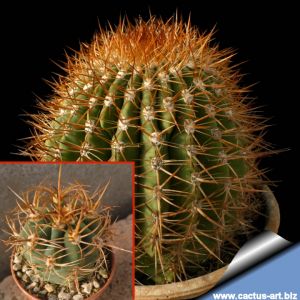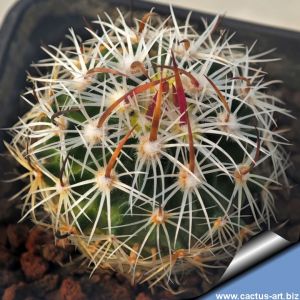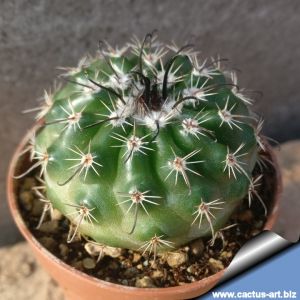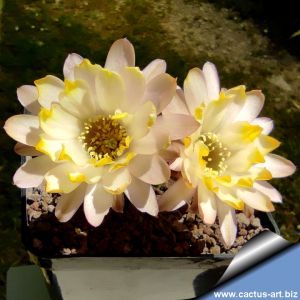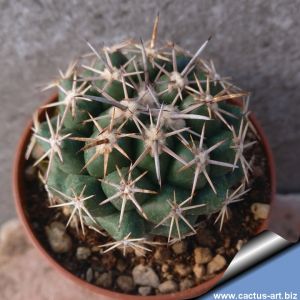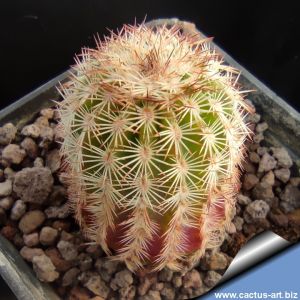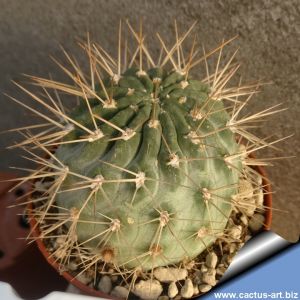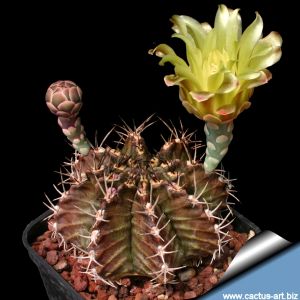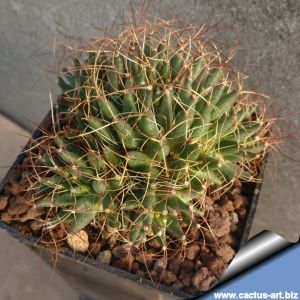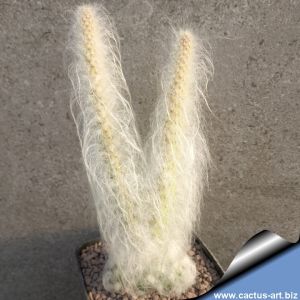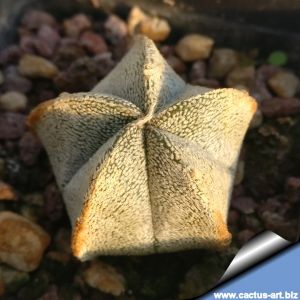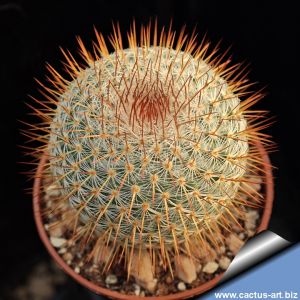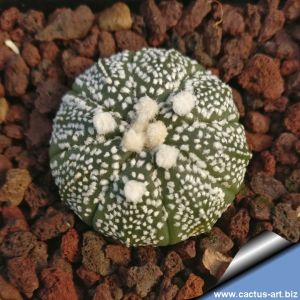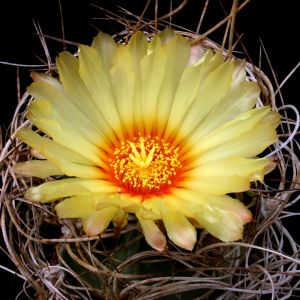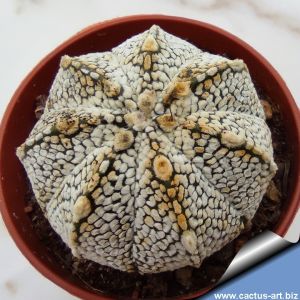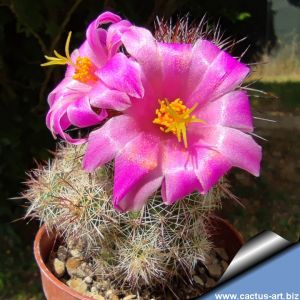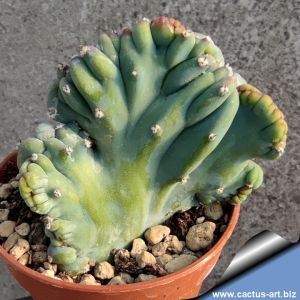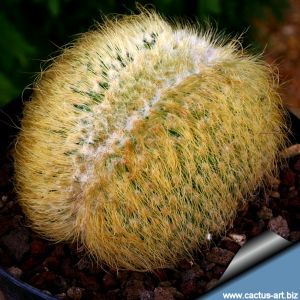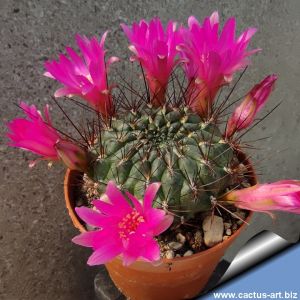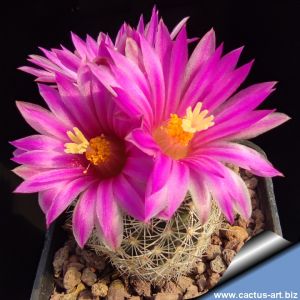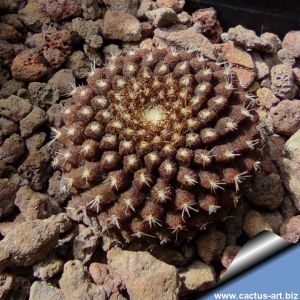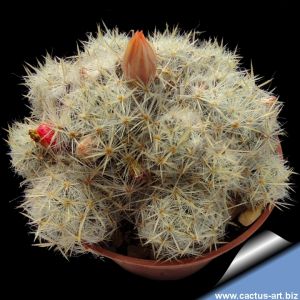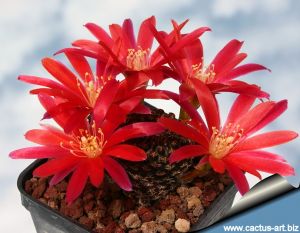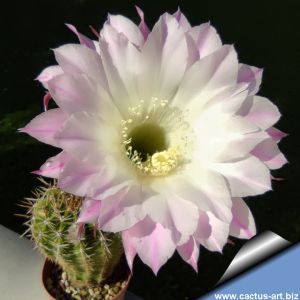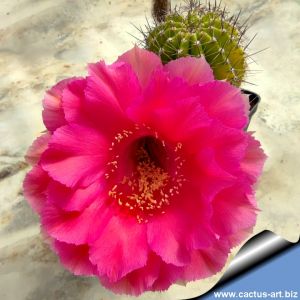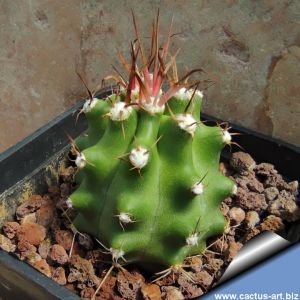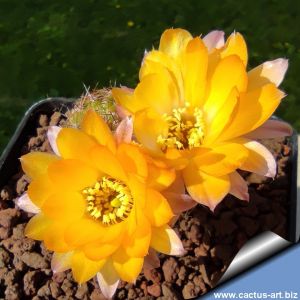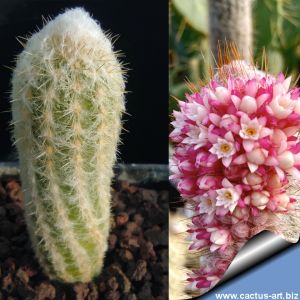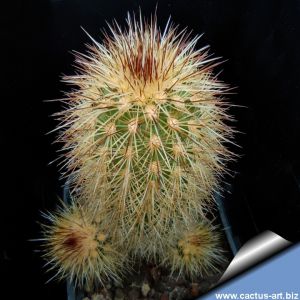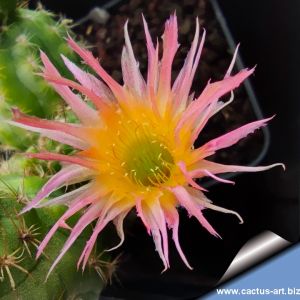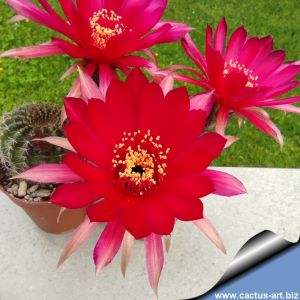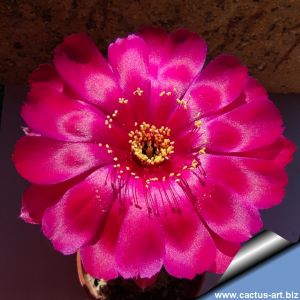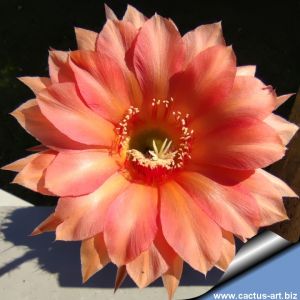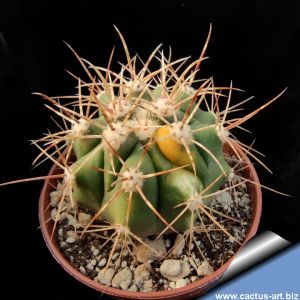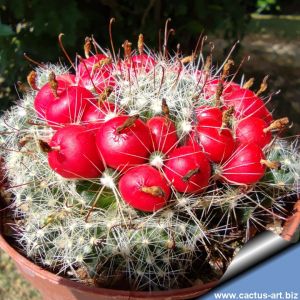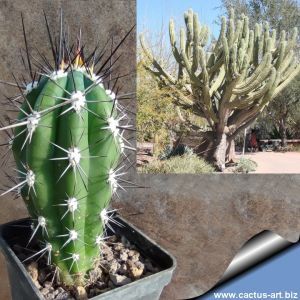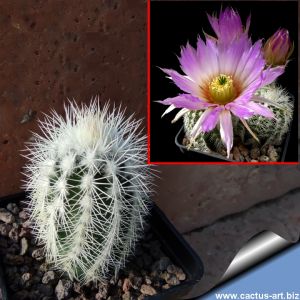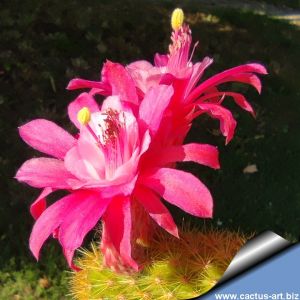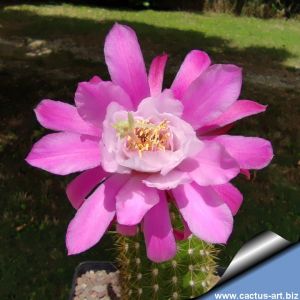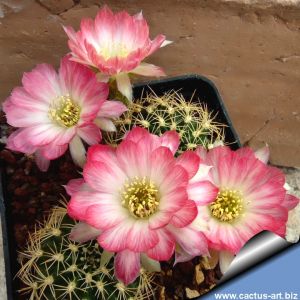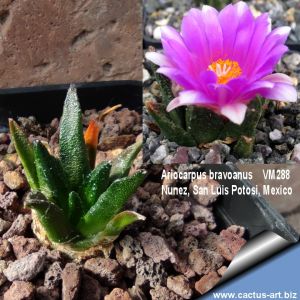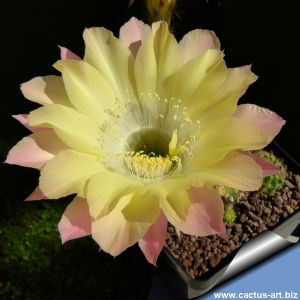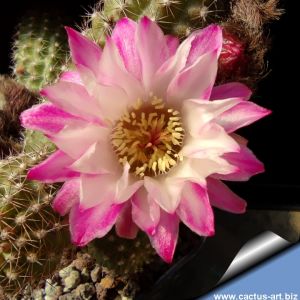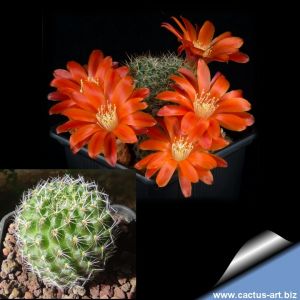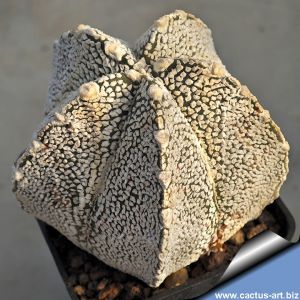-
1
Spine corte e pettinate dal giallo-beige al marroncino chiaro, con basi più scure. Crescita vigorosa e accestimento rapido, sviluppa cuscini compatti ricchi di numerose teste.
-
2
Astrophytum asterias is small, round, spineless and squat cactus. The disc-shaped body is divided into 8 ribs, greenish-brown and may appear speckled from its covering of white scales. The flowers of this cactus are yellow with red red bases.
-
3
Turbinicarpus schmiedickeanus ssp. dickisoniae is similar to Turbinicarpus schmiedickeanus ssp. gracilis the closest variety. Radials spines 18-24 white 2mm long on young areoles (areole in old specimens have only central spines).
-
4
Varietà con corpo rotondo verde scuro e spine pettinate rigide. Produce grandi fiori gialli con antere rosse. Una pianta davvero affascinante.
-
5
Cultivar compatta e distintiva, con coste suddivise in piccoli tubercoli e spine molto corte che ne definiscono l’unicità. È proprio questa combinazione morfologica a renderla unica, rendendola immediatamente riconoscibile a colpo d’occhio.
-
6
Lobivia jajoiana is a very popular small cactus priced for the throat ring of the flower that is always of a very dark purple-violet to black. The var. fleischeriana has orang or red flowers.
-
7
Very pretty plants with long pale amber to reddish central spines, pink flowers.
-
8
Fusto sferico con apice ombelicato, ricoperto da spine intrecciate di colore bruno-rossastro.
-
9
Opuntia sulphurea has conspicuously tuberculate joints. The spines are very dense and stiff, horncolored. Flowers about 4 cm. long, yellow.
-
10
Copiapoa maritima comes from a habitat with an extremely arid climate, they are remarkably tolerant of pot culture. These plants have thick taproots and are susceptible to overwatering.
-
11
Fiore bicolore spettacolare: petali rosso-mattone con linea mediana arancione e petali esterni che sfumano progressivamente in un brillante arancio-giallo. Gola scura e stami fitti color crema completano una fioritura vivace e di forte impatto visivo.
-
12
Una variante più piccola e spine chieare di Notocactus schumannianus, Notocactus claviceps raggiunge al massimo 50 cm di altezza e fiorisce in estate con fiori giallo tenue, quasi bianchi.
-
13
Specie globosa dalla tubercolatura pronunciata, con vistosi fiori gialli. Presenta 1-7 spine centrali verticali (2-7 cm), inizialmente giallastre o rossastre, poi grigiastre. La fioritura appariscente crea un bel contrasto cromatico.
-
14
Astrophytum myriostigma var. subnudum (partially naked form) is similar to A. myriostigma nudum, but deviates from it for having only a few white spots. The spots often form nice patterned designes on the dark green body.
-
15
Mammillaria carnea is a rather robust cactus species. The plant typically has 4-sided angular tubercles with yellow, woolly axils and only 4 reddish radial spines. It will reward the skilled growers with ring of fine flesh-pink flowers circling the crown.
-
16
Chamaelobivia ’Golden Eye’ is a nice hybrid with orange-red flowers. Unique character of big yellow center (Eye). EFX.ESP1, from a Chamaecereus hybrid seed mix by Edith Koch.
-
17
Gymnocalycium gibbosum var. chubutense distingushes for the unusual dark green to nearly black stem and for the cream-white or pinkish flowers. In its habit during winter there are heavy snows and frosts can occur throughout the year.
-
18
Mammillaria viperina forms fingerlike stems up to 20 cm tall and less than 2,5 in diameter. Small gray and black spines adorn the stems. Flowers are dark pinkish-red to carmine.
-
19
I fiori sono diversi l'uno dall'altro. Alcuni hanno petali sottili e affilati mentre altri sono più normali. Strane caratteristiche !
-
20
Fiori rosa pallido. I petali cambiano forma in modo significativo tra le fioriture: possono essere sottili e frastagliati, lisci e interi, o presentare una morfologia intermedia, anche contemporaneamente sulla medesima pianta.
-
21
-
22
-
23
Questa variante di Echinocereus rigidissimus v. rubrispinus L088 ha spine bianco-crema anziché rosso-violacee. L’aspetto unico della spinazione serrata e ben disposta ne fa una delle forme più attraenti tra gli Echinocereus.
-
24
Denmoza rhodacantha cv. Orange Spines is an outstanding cultivars with strong orange to rich-amber coloured spines instead of brownish red. This plant has been selected in cultivation and is propagated by controlled pollination.
-
25
Cactus globulare con costolature strette e sinuose. Spine radiali vitree biancastre contrastano con le tre spine centrali marroni appuntite, di cui quella mediana è caratteristicamente appiattita.
-
26
Eriosyce chilensis v. albiflora is a beautiful cactus with pale green stems cowered with dense whitish-yellow to brownish spines. The flowers are produced in summer, closely packed apically from young areoles, they are flattish, usually creamy white.
-
27
Parodia subterranea (also found in cultivation as Notocactus occultus) is an amazing white-topped cactus species from Bolivia that reputedly grows almost completely hidden below the soil. The flower colour is usually red, but can be quite variable.
-
28
A beautiful bloomer, Chamaecereus hybrid (Chamaelobivia) cv. LINCOLN LEMON SORBET, features gorgeous white and yellow flowers from spring to summer.
-
29
Coryphantha difficilis è un cactus a lento sviluppo e longevo che inizia a riprodursi solo dopo 15 anni. Le sue spine ricurve variano dal bianco al rosso ruggine e, di norma, non forma cespi per via di polloni.
-
30
Echinocereus × roetteri (sin. E. dasyacanthus var. roetteri) è un ibrido naturale tra E. coccineus e E. dasyacanthus. La forma SB 993, raccolta da Steven Brack nella Contea di Otero (Nuovo Messico), si distingue per i fiori di un rosso brillante e intenso
-
31
-
32
Gymnocalycium mihanovichii v. filadelfiense cresce solitario, con fusto bronzo-verde scuro (4×5-6 cm) a coste marcate striate di bianco. Produce fiori verde-giallastri o rosa dalla consistenza sericea e brillante.
-
33
Pianta che forma cespi appiattiti di fusti con tubercoli allungati e spine sottili e attorcigliate che avvolgono il corpo (da cui il nome "Cactus Nido d’Uccello"). Questa forma ha spine color crema opaco-marrone. Ideale per vasi bassi.
-
34
-
35
-
36
Delicata forma variegata con base dei tubercoli giallo crema. La variegatura si accentua con luce filtrata, mentre in pieno sole la pianta tende a rinverdire.
-
37
Mammillaria conspicua si distingue dalle altre forme del complesso Mammillaria haageana per il portamento spesso solitario e per i fusti più grandi, fino a 10–11 cm di diametro. Ogni testa è circondata da un anello completo di fiori stellati rosa magenta.
-
38
Astrophytum asterias cv. Ooibo is similar to the standard A.asterias, but it has very large characteristic and woolly areoles. So it is easily distinguishable from the common asterias that has relatively small scarcely woolly greys-white areoles.
-
39
Astrophytum senile è una varietà di A. capricorne con splendidi fiori gialli e centro rosso. Le sue spine lunghe e flessibili sono così fitte da nascondere quasi del tutto il fusto, conferendogli l’aspetto di un fascio di erba secca.
-
40
Ibridi da impollinazione controllata tra ♀A. asterias "SUPERKABUTO" e ♂A. coahuilense. Tipicamente con 8 coste più affilate rispetto al "SUPER KABUTO" (segno dell'influenza del coahuilense), con un'affascinante copertura di larghi punti lanuginosi.
-
41
Mammillaria occidentalis also known as Mammillaria mazatlanensis var. occidentalis is a clumping species which has large pink flowers in summer. The flowers are slightly scented. These can be followed by red fruits.
-
42
Varietà giapponese che unisce le enormi areole lanose tipiche degli "OOIBO" con l'epidermide verde puro del "RURI KABUTO". Un Astrophytum iconico. Piante da seme mai innestate.
-
43
-
44
Notocactus leninghausii or the "Golden Ball Cactus" is very popular and widely grown for its yellow bristly appearance, but this beautiful crested form is still rare in cactus collection. The most striking feature is the harmless, bristly golden spines.
-
45
Is a globose dwarf cactus that forms clumps with age. The body is flattened dark green or purplish. The spines are needle-like brown to almost black of which 3-6 stronger centrals. The flowers are bright purple.
-
46
Thelocactus rinconensis è uno dei cactus più ornamentali dei deserti messicani, estremamente variabile nelle spine. Questo cultivar mostra un elegante corpo glauco e spine lunghe, color corno scuro fino al nero, particolarmente coreografiche.
-
47
Gymnocactus beguinii is a small usually solitary, globose cactus with magenta funnel-shaped flowers. The anthers are dark chrome yellow. The style is creamy white.
-
48
Eriosyce aerocarpa FK564 (syn: Eriosyce odieri ssp. glabrescens, Thelocephala nuda, Eriosyce napina) is a beautiful form with very short spines.
-
49
-
50
La varietà condorensis si distingue per i fiori rosso scuro. I fusti, più grandi e globosi, sono ornati da spine brevissime, dando l’aspetto di sfere ricoperte di minuscoli ragni bianchi.
-
51
-
52
-
53
-
54
-
55
Scoperto nel 2005, Micranthocereus polyanthus ssp. alvinii del Bahia, Brasile, è un cactus sottile e affascinante. I fusti sono ricoperti di spine bianco-gialle, e all'apice sbocciano piccoli fiori rosa-rossi.
-
56
E. freudenbergeri L1032 si trova nella Sierra de la Paila, dove cresce insieme a Gymnocactus aguirreanus e Escobaria zilziana. Ha fusti cilindrici che formano cespi, spine gialle fitte, una spina centrale marrone allungata e fiori rosa straordinari.
-
57
-
58
-
59
Fiore spettacolare, di un rosso-viola brillante con riflessi fluorescenti che sembrano illuminarsi alla luce. Petali lucidi, disposti in più ordini, formano una corolla compatta; la gola scura esalta il contrasto con gli stami giallo-oro.
-
60
-
61
-
62
Mammillaria oteroi clusters freely and the offsets detach readily. It has some of the roundest fruits among mammillarias. The fruits are globose, 7-8 mm long, bright red. Flowers are pale yellowish green with muddy cerise midstripe.
-
63
Stetsonia coryne, l’unica specie del suo genere, è un imponente cactus colonnare che raggiunge i 3–10 metri di altezza e caratterizza in modo distintivo i deserti caldi argentini. È rinomata per le spine feroci, che possono misurare fino a 10 cm.
-
64
Forma nana del sottospecie baileyi, nota come 'minor' (albispinus) con fusti ricoperti da spine bianche. I fiori sono rosa medio con gola chiara, eleganti e ben evidenziati. È una pianta "winterhart", in grado di resistere a temperature sotto lo zero.
-
65
Fioritura con petali interni rosa-bianco sfumati di violetto, mantenuti in forma semimbutiforme con margini e apici increspati. I petali esterni, rosa-viola più scuri e ricurvi, talvolta mostrano una leggera velatura rosa-arancio sul retro.
-
66
Fiori grandi (10-12 cm di diametro) simili a Hildewintera 'Otto Schultz' ma più grandi, con petali interni bianco-rosati che sfumano verso l'esterno in un rosa più intenso. Pianta vigorosa e di facile fioritura.
-
67
-
68
Piccolo cactus geofita, di grande bellezza, con rosetta solitaria composta da tubercoli verrucosi verde scuro.
-
69
Fiore elegante con cuore color arachide e delicata sfumatura rosa sulle punte dei petali. Una combinazione raffinata e armoniosa. Ibridatore: Paolo Panarotto..
-
70
-
71
Rebutia poecilantha is a small cactus specie with bright crimson flowers collected at north of Camargo, in bolivia by F. Ritter (field number FR1139). It is a very nice plant and it will be worth for a place in every cactus collection.
-
72
NUOVO ARRIVO! Bellissima cultivar dalla Thailandia, caratterizzata da ampie macchie lanose che creano un pattern bianco brillante sulle coste. Quantità molto ridotte e nessuna certezza di nuove disponibilità.

